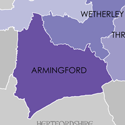The West Cambridgeshire Hundreds
Ancient woods to explore (while still open)*
News

By Peter Mann
According to the Wildlife Trust for Beds, Cambs and Northants, the West Cambridgeshire Hundreds is ‘a collection of wildlife rich ancient woodlands in an area defined for over 1000 years by the old Anglo-Saxon regional divisions known as the Cambridgeshire Hundreds’.
Buff Wood in East Hatley, Hayley Wood in Little Gransden and Gamlingay Wood are three of our local ancient woodlands – Hayley Wood, Gamlingay Wood and other woods (but not Buff Wood) are detailed on the Wildlife Trust’s West Cambridgeshire Hundreds website page.
The latest (March 2024) newsletter has more local detail.
As ever with things ancient, there’s the quirky thing of East Hatley being in the Armingford Hundred and Hatley St George in the Longstow Hundred.
And while Warseley and Great Gransden are local to us, they are in the Toseland Hundred in Huntingdonshire and so, strictly speaking, not part of the West Cambridgeshire Hundreds.
Beware – they may be closed!
While currently now open, these woods are having bits closed off at times as part of the Wildlife Trust’s maintenance programme, so if you want to go for a walk in Waresley and Gransden Woods be aware they may be closed; details of what is being done are on the Wildlife Trust’s website).
When that work is completed, the contractors will move to Gamlingay Wood, which may also be closed.
What is a ‘hundred’?
A hundred is an administrative division which is geographically part of a larger region.
Between early medieval times (circa 850 AD) and the 19th century, Cambridgeshire was divided into 17 hundreds, plus the borough of Cambridge. Each hundred had a separate council which met every month to rule on local judicial and taxation matters.
Wikipedia (as you might expect) details the Cambridgeshire Hundreds and the Hundreds of Huntingdonshire.
Exploring the hundreds
Hatley is a great place for wildlife – because there’s such a wide variety of habitats and places where plants and animals live.
And we humans are very fortunate to have so many footpaths and bridleways running to and from East Hatley and Hatley St George.
If you really want to, you can probably make your way from Hatley to almost anywhere in the country via the UK’s unique, extensive and mostly very ancient rural footpaths and by-ways.
There’s much more on this, including ‘definitive maps’ showing all the footpaths and bridleways around Hatley, on our Countryside around Hatley page.
NB Woods managed by the Wildlife Trust are closed from time to time for ‘essential maintenance’ – so always best to check the Know before you go page of their website for up-to-date news.
Post created 9th August 2022; updated 12th February 2024.

